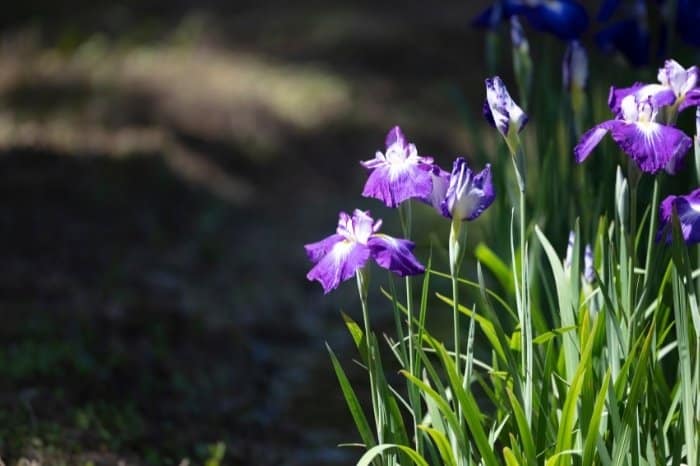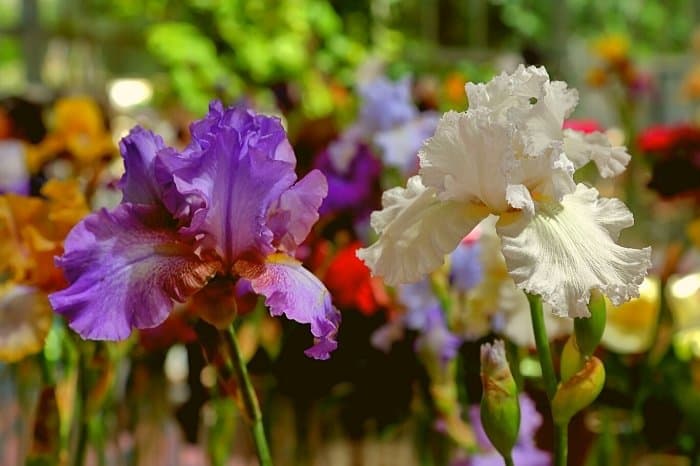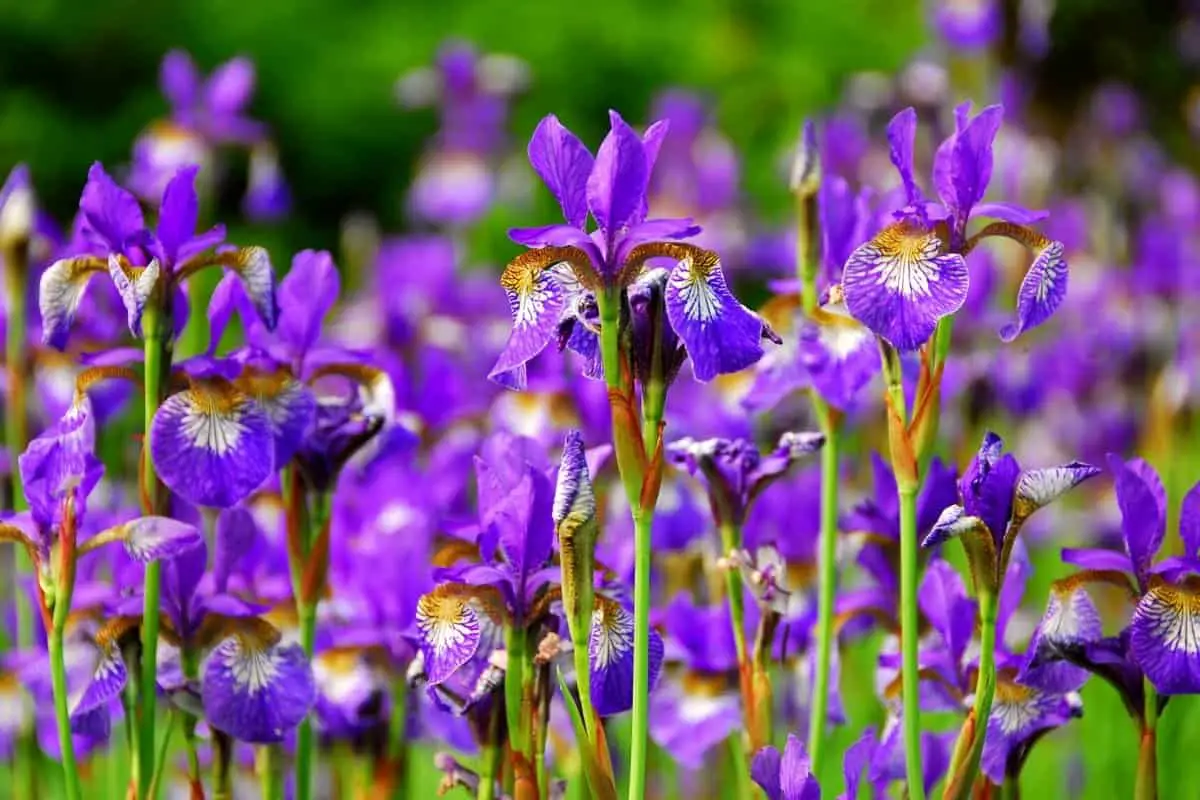Last Updated on February 22, 2023 by Griselda M.
When do irises bloom? There are many different types of iris with over 300 species, and many of these have been bred, hybridized, and selected to produce thousands and thousands of cultivars. Because of this diversity, there is an iris that will bloom early and late for nearly every climate on Earth. So, when do irises bloom? Read more to find out.
Irises are broadly divided into those that form rhizomes and those that form bulbs. These plants are extremely successful with species having adapted to grow from the Arctic circle to the equator. There are even species that grow in some of the most inhospitable deserts on Earth.
When Do Irises Bloom?
To actually answer this question is impossible in anything less than 100 pages of text! Irises can bloom nearly any time of year when the conditions are correct for the specific species or cultivar you are growing. The nice thing about the Iris is that it is so popular that most nurseries and garden shops will tend to carry a few plants that they know grow well in your area. This means you can get into the Iris game with low-risk plants that are known to tolerate your local climate.
Once you get the hang of these “easy” plants, you can then graduate to the more geeky technique-heavy plants. I find that there are always local gardening groups on social media, and if you track one of these down, there are lots of people who are into a specific plant, and you can glean a lot of free information – and often plants – from these groups.

Here are a few relatively surefire Irises you can try:
Some Japanese Irises and Siberian Irises bloom from mid-spring to early summer. The beardless Southern blue flags bloom into early summer.
Once you have a full garden of bearded irises and they bloom, you will experience something magical. I went through an Iris stage and grew them in pots so that I could bring the pots indoors in my sunny areas as accents when they flowered. I bought a mixed bag of different irises and just brought them in as they flowered. Now I mainly grow African Irises in the garden for accent beauty and ground cover. I gave my Iris collection to somebody who had a garden more suited to them. I regret this at times but Irises need a lot of direct sunlight, and for me, I have other things that need direct sunlight more.
Some Irises can survive outdoors from Zone 3 upwards, and a few specialist plants that can survive lower zones.
When Are Irises in Season?
Some Irises flower in the middle of winter, such as the Algerian Iris. Some Irises flower when it rains, such as the Negev Iris. There is the majority of Irises that flower from mid-spring onwards.
Basically, you have an Iris for every season, and you can just search for Iris on Amazon – there will be lists and lists of bulbs and rhizomes and plants for sale, and you can see the flowering time listed for each variety. Choose the ones that suit your needs.
How Many Times Do Irises Bloom Per Year?
There are two or more varieties of the iris that bloom a couple of times per year. If you notice gardens blooming throughout the year, they have several varieties that extend the bloom in different periods of the year.

Different Irises have different soil needs. When you buy your plants, read the specific soil needs for that plant. Provide accordingly. Japanese Irisis, for example, prefer pretty water-retentive soil, whereas many others need moist soil with good aeration and drainage. I have never found an Iris that does not like a good mulch.
A two-inch layer before they emerge helps suppress leaves, and I normally then top dress this as the plants get larger with more mulch. The mulch degrades and provides nutrients for the plants. An iris is a funny thing – if it gets too many nutrients, it will not flourish. Hence I sprinkle about a cup of bone meal per square yard of iris-covered soil and cover this with mulch. That is all your irises really need. I do this in spring and fall. Some years I skip the bone meal as my soil is healthy.
The irises will bloom well if you plant them in well-drained moist soils for bearded irises to slightly water-logged soils for Japanese irises. Most irises such as the miniature bulbous irises, and Siberian irises need moist soils and good drainage to thrive. They also need full sun or some cultivars may tolerate light shade.
How Long do Irises Bloom?
Most Iris species have a single blooming cycle from spring to summer. There is however the bearded Iris group of plants and hybrids that can be encouraged to bloom twice. Each specific plant type has a slightly different set of triggers for this, but generally, cutting the flowers, and mulching and fertilizing the plants can cause a second flowering cycle.
Plants that can be induced to flower again display a trait known as remontancy.
The African Iris
The African Iris is Dietes iridoids. This plant falls in the Iridacea, which includes Irises, Freesias, Gladioli, and Crocus plants among others. It is not particularly closely related to the rest of the Irises we have been talking about, but it is a lovely plant to grow.
Unlike the other Irises, the African Iris will thrive in shade. It will also thrive in direct sunlight. It tolerates drought, waterlogged soil, frost, and some snow. This plant is tough!! It can become quite a pest at times. It will outcompete weeds.
I love to grow them, and just stick them in any place where I cannot get other plants to grow. It will normally hang in there and crawl along. The plants put out single flowers that last a few hours – so it is not a cut flower plant. They sometimes make these little plants on the flower stalks, and these will touch the ground and grow – retaining a connection to the parent plant. In this way, they can walk quite quickly across your garden.
What to Do With Irises After They Bloom
This depends on the type of Iris. If it is a bearded Iris, trim off the flowers and you may be lucky and get another flowering!! If it is any other type of Iris, I just let them do their thing. African irises flower a lot, and for no apparent reason, at nearly any time of year. If they end up getting scraggly and covered in old flower stalks, just trim these off. Do not throw them in the compost heap if you do not wish to have more African irises growing in your compost heap.
What If My Irises Do Not Bloom?
Sometimes it is true irises may not bloom at all. Bearded, Asian, classic, or designer, these flowers are beautiful to grow in your garden. They provide a long display of tall, glorious sword-like leaves and boldly featured blooms.
So what happens when they don’t bloom? When irises don’t bloom, they only produce beautiful foliage but the long-awaited flowers refuse to appear. This is frustrating for any gardener. Frustrating as it is, if you correct the conditions causing the lack of flowering, you will be back on track to getting decent flowers.
Reasons for Irises not blooming
-
Poor Rhizomes Or Bulbs – They could be rotten, mushy, small, or under-formed.
-
Stunted Plants – these do not produce any blooms or if they do, they produce small blooms. Bone meal and mulch solve the problem.
-
Planting In Shady Areas – Irises need full sun to bloom, if they grow in fully shaded areas, they will not bloom.
-
Dead Plants – This may come from overwatering or poor rhizomes
-
Poor Soil – If your soil is not well-draining and is not fertile it might cause infertility in the plants. Check your soil to see if the pH and fertility are consistent with the ideal pH of 6.8 with average nitrogen levels and sufficient phosphorous. In some cases, irrigation water can be a bit alkaline, and this will damage the plants.
-
Overcrowding – If you grow your iris plants too close to each other they will not bloom because they will share the nutrients until there is none to support the bloom. Dig up the overcrowded clumps and plant each rhizome individually with enough nutrients. Transplant your rhizomes frequently to avoid overcrowding.
-
Late Freezing – Although irises tolerate very cold temperatures, if they do not sprout at the right time, or if the early leaves and stems succumb to freezing the plant will not bloom. Freezes experienced by plants 6 to 8 weeks before bloom will abort the buds and stop the blooming.
6-10-10 Controlled Release Iris Food
Insects and diseases are rarely a problem only if you compromise the health of the buds. But if you take good care of them you will have healthy bloom at the right time.
Conclusion
When do irises bloom? When that specific type blooms. Luckily there are so many types to choose from, you can get Iris flowers going in your garden for much of the year. What makes them not bloom? Being outside their comfort zone. This can be corrected, as we have described by mulching, feeding bone meal, and making sure the soil pH is right.
FAQs
What month do irises bloom in?
Iris is a spring-flowering plant and the flowers open from early April to mid-May. It's the only species of Iris that can be used as an ornamental flower. In the UK, the most popular variety is the Double Dutch iris (Iris × hollandica 'Double Dutch') which blooms from late April to early May.
The plant is very tolerant of heat and drought and can grow in full sun or part shade.
How do you keep irises blooming?
Caring for your Iris is very important. They need love, water and a little bit of attention. Here are some simple tips to help you get started caring for your irises. Watering the iris is the most important thing to do. Irises like to be kept moist. If you live in a dry area or climate, make sure that the soil is not completely dry.
You should water them every day and that the less you disturb their roots the better. Irises need water but too much water can also cause problems. Water the plant for 10 minutes every two days. This is enough time to keep the soil from drying out.
Make sure that the soil is rich and well drained. If it is too wet, the roots will rot and the plant may die. When it is too dry, the roots can wither and die.
Also,
1. Remove any dead leaves. They are not good for the plant and they can cause disease.
2. Place your iris in a warm location. Irises like to be in a place that has bright light. A bright window is fine but you should not place the iris in direct sunlight.
3. Add a small amount of fertilizer to the soil once a month.
How many years will irises bloom?
Iris are perennial flowers. The flower buds on the stems of an Iris grow into flowers that bloom for several weeks in early spring. If you have a flower bed or garden, Iris are easy to grow from seed. They can be planted in a variety of soils and in full sun to partial shade. Some are hardy to Zone 3 and some are hardy to Zone 4.
Iris are native to Eurasia and Africa. They were introduced into North America by Europeans. Today there are more than 350 species of Iris. Plant Iris in early spring when the soil is moist and the temperature is above 50 degrees Fahrenheit. You may transplant them in late summer after they’ve finished flowering and have set seed. Be sure to provide enough light and water to ensure good germination.
Why do irises stop blooming?
Iris is a flower that blooms all year round. I know it's been bloomed in the spring, summer, autumn and winter. But why do some iris flowers stop blooming? A: There are two main reasons that I have seen for this. First, if you plant your iris in the fall and leave it in a cold spot until next spring, they will stop blooming.
They may bloom again after you bring them inside, but not before the cold weather sets in again. Second, some people keep their iris in pots or planters and bring them into the house to protect them from the cold. If they are kept in these containers during the winter, the plants will stop blooming.
FAQs
What month do irises bloom in?
Iris is a spring-flowering plant and the flowers open from early April to mid-May. It's the only species of Iris that can be used as an ornamental flower. In the UK, the most popular variety is the Double Dutch iris (Iris × hollandica 'Double Dutch') which blooms from late April to early May.
The plant is very tolerant of heat and drought and can grow in full sun or part shade.
How do you keep irises blooming?
Caring for your Iris is very important. They need love, water and a little bit of attention. Here are some simple tips to help you get started caring for your irises. Watering the iris is the most important thing to do. Irises like to be kept moist. If you live in a dry area or climate, make sure that the soil is not completely dry.
You should water them every day and that the less you disturb their roots the better. Irises need water but too much water can also cause problems. Water the plant for 10 minutes every two days. This is enough time to keep the soil from drying out.
Make sure that the soil is rich and well drained. If it is too wet, the roots will rot and the plant may die. When it is too dry, the roots can wither and die.
Also,
1. Remove any dead leaves. They are not good for the plant and they can cause disease.
2. Place your iris in a warm location. Irises like to be in a place that has bright light. A bright window is fine but you should not place the iris in direct sunlight.
3. Add a small amount of fertilizer to the soil once a month.
How many years will irises bloom?
Iris are perennial flowers. The flower buds on the stems of an Iris grow into flowers that bloom for several weeks in early spring. If you have a flower bed or garden, Iris are easy to grow from seed. They can be planted in a variety of soils and in full sun to partial shade. Some are hardy to Zone 3 and some are hardy to Zone 4.
Iris are native to Eurasia and Africa. They were introduced into North America by Europeans. Today there are more than 350 species of Iris. Plant Iris in early spring when the soil is moist and the temperature is above 50 degrees Fahrenheit. You may transplant them in late summer after they’ve finished flowering and have set seed. Be sure to provide enough light and water to ensure good germination.
Why do irises stop blooming?
Iris is a flower that blooms all year round. I know it's been bloomed in the spring, summer, autumn and winter. But why do some iris flowers stop blooming? A: There are two main reasons that I have seen for this. First, if you plant your iris in the fall and leave it in a cold spot until next spring, they will stop blooming.
They may bloom again after you bring them inside, but not before the cold weather sets in again. Second, some people keep their iris in pots or planters and bring them into the house to protect them from the cold. If they are kept in these containers during the winter, the plants will stop blooming.
Caroline is a gardener who loves to get down to the nitty–gritty of gardening. She proudly proclaims herself as a ‘dirt worshipper‘ and can often be found deep in the garden, covered in soil and singing to her plants. As a self–proclaimed ‘plant whisperer‘, Caroline believes that plants need love and attention just like any other living thing, and she loves to give them both. When she‘s not tending to her garden, you can often find her researching the latest gardening trends, or teaching others how to make their gardens thrive



